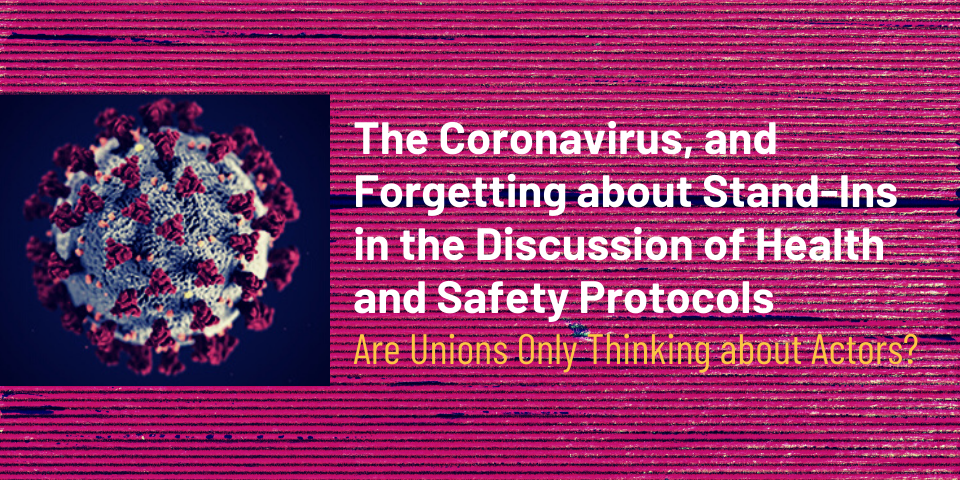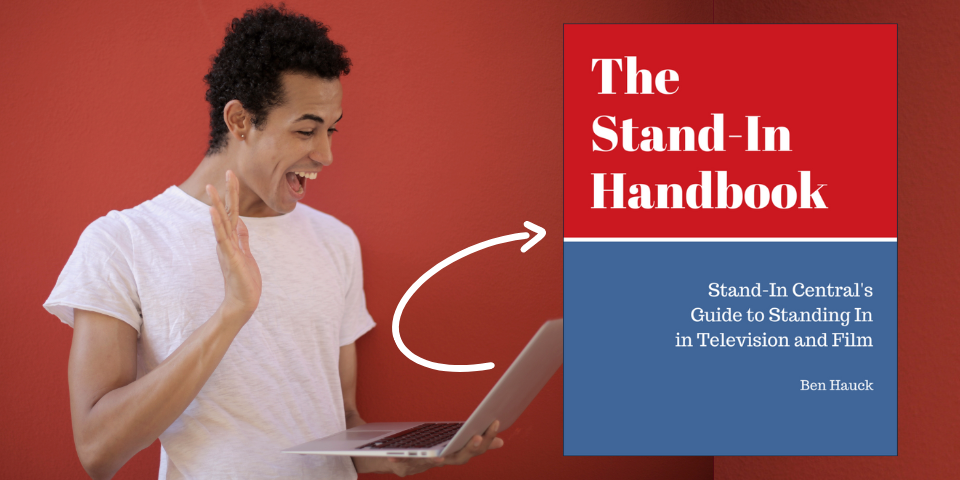This post is part of Stand-In Central’s deep-dive series into the coronavirus pandemic as it relates to stand-in work in TV and film. For more posts in the long-running series, visit https://standincentral.com/coronavirus.
— The Editor
One of Stand-In Central’s biggest fears after work returns is that stand-ins will be forgotten in the calculation of health and safety protocols.
The fear is stand-ins will show up to work, protocols will be worked out thoroughly for crew members, principal actors, and background actors, but — whoops! — there are not protocols to handle the unique work stand-ins do.
Mind you: That’s not a whoops!, but a realistic health and safety threat to stand-ins, as well as actors and crew, if not worked out.
Here’s more on why.
The Argument Is There That Stand-Ins Are Being Forgotten
The argument is there that stand-ins are being forgotten. To date, Stand-In Central has located no public articles outside of those on this website that speak to the concerns of TV/film stand-ins during the COVID-19 pandemic.
Take directors of photography (DPs), sometimes known as “cinematographers.” DPs work intimately with stand-ins to light shots for dramatic television and feature films, sometimes putting light meters very close to stand-ins’ faces and at times handling stand-ins (much to their dismay and disgust). For many scenes, DPs require stand-ins to stand very close to each other (i.e., within six feet) to light the shot.
In this day and age, each of these instances presents a health risk to stand-ins given social distancing and the contagious nature of the novel coronavirus.
IATSE Local 600 — the International Cinematographers Guild — recently did a video update for its members (namely DPs and camera crews). As recently reported by Deadline, ICG Local 600 president John Lindley said [underline added for emphasis]:
Recently, the conversation has been shifting away from when will we get back to work to how will we get back to work. A lot of [ICG] members are asking about how they’ll be able to work safely when the work comes back, and I think it depends a little bit on the genre. In live broadcasting, there’s going to be sports where there won’t be fans and camera crews will be able to stay a safe distance away from the players. And there are game shows and live audience shows where the audience will be kept away but the camera crews can be safe. It’s a little different in film and television, where actors will be the limiting factor, since they can’t wear the protective gear that’s available to us as crew members.
It’s not as if Lindley needed to do a shoutout to stand-ins in a video update for DPs and camera crews, but this passage helps set the stage that the ICG apparently is thinking about actors, but the concern for stand-ins does not seem to be there — even though DPs work intimately with them about as much as they do with principal actors, if not more.
Add to that comment that Lindley seems to classify people on a set as “actors” or as “crew members.” Stand-ins are often referred to as “crew,” which in the view of Stand-In Central is a wrongheaded and problematic word choice; stand-ins are better classified as “quasi-crew” in order to acknowledge their unique and borderline nature in the production world.
That borderline nature means that many times, stand-ins are the least-informed people on set. They know less than crew members do because they may not get the callsheets in advance, outlining the day’s work. And sometimes they know less than the background actors, who many times are given more information about the production day from background casting directors than stand-ins are given.
This is to say stand-ins may not be clued into any health and safety protocols when they report to work, which means they may be at higher risk when they are working because of a historically established lack of information they get about health, safety, and production days.
SAG-AFTRA’s Concern for Actors (… And Stand-Ins?)
When it comes to SAG-AFTRA, union publicity seems to be focused on its actors at this time.
The term “actors” sometimes means both principal actors (known in the TV/Theatrical Agreement as “performers”) and background actors (decidedly not “performers” in the TV/Theatrical Agreement).
But sometimes when people hear the word “actors,” they think it refers more or just to those people who have lines. When talking about actors, the unique needs and interests of background actors don’t come to mind, even though they too are actors, and most are union brothers and sisters.
Even worse, many people hear the word “actors” and only think of movie stars and other highly paid performers. In such a case, the needs of day-playing actors with lines, supporting actors, and guest stars, as well as background actors, don’t come to mind.
More to the point, what doesn’t come to mind when talking about actors is stand-ins. As far as Stand-In Central has seen, SAG-AFTRA has not published anything to date that addresses the unique situation of stand-ins during the pandemic. Instead, SAG-AFTRA and namely its executive director David White have pushed arguably high-level speech about what it and other unions are doing to address the return to work. White told Deadline recently:
We’re working aggressively with industry safety experts and coordinating with other guilds and unions on this issue right now.
Deadline also quoted two different unidentified industry sources (why unidentified at this time is a wonder) about the work being done:
Plans are happening but it’s premature to discuss them right now.
And:
A lot of conversations are happening.
I don’t doubt that SAG-AFTRA is “working” right now and that people are in the industry are having “conversations” or making “plans.” But these reports don’t mean anything practical. That SAG-AFTRA is working or that industry people are having conversations or making plans is not news.
Furthermore, the word “aggressively” is union marketing language and potentially propagandistic, putting a spin on the work SAG-AFTRA is or isn’t doing right now that Deadline can’t measure as a factual statement. Without pressing or challenging White about what it means to “work aggressively,” Deadline potentially makes itself into a speech platform for White and SAG-AFTRA rather than a source of legitimate news and journalism right now.
What stand-ins fear is that that “aggressive work” and “conversations” and “plans” that give no real consideration to the job of stand-ins means little to nothing to stand-ins’ health and safety when they are working their particular jobs. Since 2010, Stand-In Central has outlined in granular detail the many aspects of stand-in work, so it is not as if there is no public information about the many facets of working as a stand-in.
As far as stand-ins are concerned, SAG-AFTRA could be working slowly, methodically, meekly, or in some other way, as long as the result of that work is that proper protections for stand-ins are in place when they next report to work.
Get Low-Level
Without the advice from workers on health and safety protocols, namely stand-ins, SAG-AFTRA can’t know if the protocols it puts in place will cover the unique work of stand-ins during and after the COVID-19 pandemic.
Given that stand-ins are often forgotten with respect to information, the concern is real that they will continue to be forgotten in the discussion of a return to work.
And because the talk is sufficiently high-level, that means right now that stand-ins can’t know what is being discussed, and the unions, including SAG-AFTRA, can act as if they are talking about every possible permutation. They can appear to be addressing everything without having the accountability of actually addressing everything.
This is all to say: Protect yourself. Don’t assume you are sufficiently protected by your union, which largely protects actors. Don’t assume that “actors” also means stand-ins. Stand-ins do things on a set that many actors don’t do, and stand-ins interact with crew members in ways that actors don’t. Stand-ins fall through the cracks, as Stand-In Central has long established. And that falling through the cracks can have very real implications on your health and safety amid the pandemic.
Reactions? Thoughts? Post your comments below!







Leave A Comment